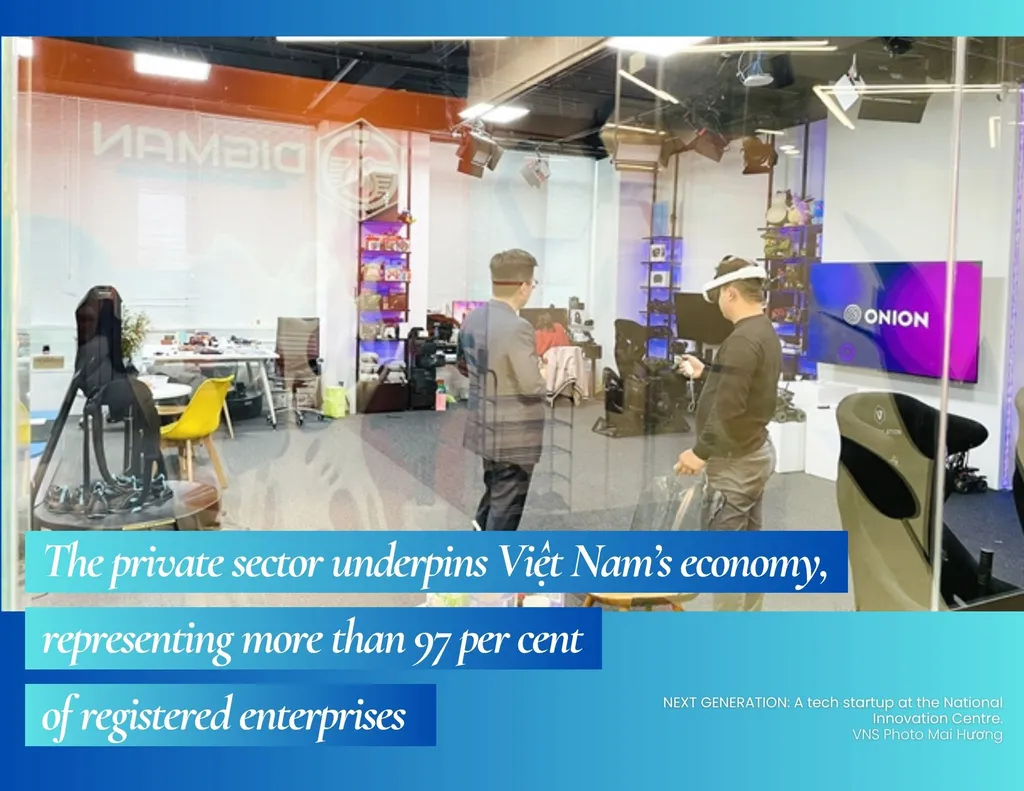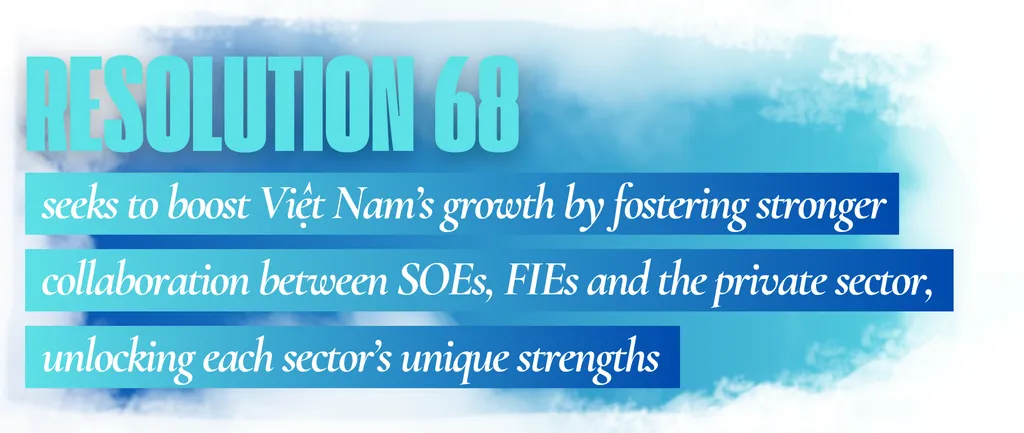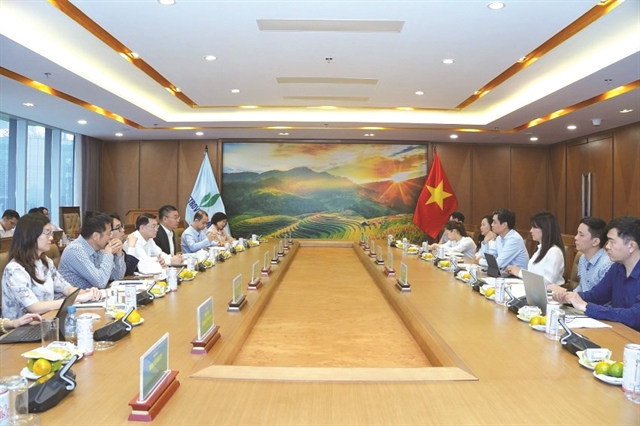 Economy
Economy

 |
The private sector in Việt Nam has been recognised in recent years as a crucial driver of innovation and economic growth. Contributing more than half of the nation’s GDP and providing 85 per cent of jobs, it has played an integral role in the economic transformation that Việt Nam has undergone.
Despite its importance, the private sector, however, has faced numerous challenges, particularly in its ability to scale and innovate in a competitive global market. This is where the Government’s recent efforts, particularly after the Politburo of the Việt Nam Communist Party passed a resolution on private economic development (called Resolution 68), play a crucial role in supporting the growth of the private economic sector.
One of the key strategies highlighted in this resolution is the development of a strong, collaborative tripartite linkage between private enterprises, State-owned enterprises (SOEs) and foreign-invested enterprises (FIEs).
By fostering this synergy, the government seeks to create a cohesive ecosystem where the strengths of each party can complement one another, driving innovation, increasing competitiveness and contributing to sustainable, inclusive economic growth.
As Việt Nam targets double-digit GDP growth in the next decade, the emphasis on building these partnerships is seen as a strategic pillar powering the country’s push for industrialisation, modernisation and global integration.
The private sector in Việt Nam has grown significantly over the past few decades. With over 97 per cent of registered enterprises classified as private, the sector is the backbone of the Vietnamese economy.
 |
It has contributed to the development of various key industries, from agriculture and manufacturing to services and technology. Private businesses, particularly small- and medium-sized ones, are the main creators of jobs and have spurred significant advances in innovation and productivity.
As of 2024, the total number of active enterprises in the private sector reached around 930,000, with several major private conglomerates emerging, such as Vingroup, Masan, Sun Group, Vietjet, and Thaco.
However, as Việt Nam continues to integrate into the global economy, particularly through free trade agreements and partnerships with other countries, there is a growing need for private businesses to overcome challenges such as limited access to capital, fragmented supply chains and inadequate technology.
Resolution 68: the push for synergy
 |
Adopted on May, 4, 2025, Resolution 68 sets out a comprehensive policy to address these challenges and unlock the full potential of Việt Nam's private sector.
The resolution aims to create a more favourable environment for private businesses, particularly smaller ones, by enhancing their access to capital, encouraging innovation, and reducing bureaucratic obstacles that hinder their growth.
Moreover, the resolution highlights the importance of fostering closer collaboration between SOEs and FIEs.
Historically, both have been dominant in key sectors such as energy, telecommunications and heavy industries. SOEs, with their state-backed resources, have often led infrastructure development, while FIEs have brought in advanced technologies and capital.
 |
On the other hand, private enterprises, particularly in Việt Nam's rapidly growing tech and services sectors, have demonstrated a high level of adaptability and innovation. Yet, they often lack the scale, capital and international reach to compete.
By recognising that each party has unique strengths, the resolution calls for a more coordinated approach that leverages the resources, expertise and networks of SOEs and FIEs while enabling the private sector to contribute its flexibility, innovation, and deep understanding of local markets.
 |
| TECH CAPABILITIES: Students test robot arm control algorithms at the Industrial University of Hồ Chí Minh City. VNA/VNS Photo Thanh Vũ |
The resolution calls for a more coordinated approach that leverages the unique strengths of each party. It proposes practical mechanisms such as joint ventures, co-investment initiatives and technology transfer programmes to enhance cooperation. This tripartite partnership is seen as essential to bridging capability gaps and ensuring inclusive, resilient growth in the new era.
A key driver
According to Phí Vĩnh Tường, deputy director of the Institute of Vietnam and World Economy, one of the biggest barriers to advancing the private sector lies in outdated perceptions about its role.
Resolution 68 acknowledges this challenge and highlights the private sector as a key driver of the economy. However, for meaningful linkages to emerge between private and state-owned enterprises, the Government must ensure a fairer legal and policy environment, especially regarding access to capital, resources, business opportunities.
“State-owned enterprises can easily get loans and join public service projects, but private businesses often face difficulties getting funding and access to these opportunities. Without equitable treatment, collaboration will remain superficial,” Tường told Việt Nam News.
In terms of FIEs, Việt Nam’s traditional approach has focused on incentives to attract foreign capital. While effective in drawing investment, this policy lacks binding requirements for knowledge sharing, technology transfer or managerial collaboration with domestic firms.
On the other side, most local private firms struggle with limited technological absorptive capacity and often fail to meet the standards or scale needed to link with FIEs. Hence, capacity-building is critical and cannot be achieved without State support.
According to Tường, to foster genuine synergy, the Government should pursue three policy directions.
First, it must improve the business environment to ensure equal treatment and opportunities for SOEs and private firms. Second, foreign investment attraction policies should go beyond incentives to include enforceable commitments for technology and knowledge transfer. Third, new policies are needed to help scale up private firms and improve their technological capabilities.
“This includes workforce training, greater access to public R&D, and deeper involvement of private firms in innovation ecosystems led by SOEs,” he said.
Additionally, the Government should boost industrial clusters and innovation hubs as platforms for cross-sector collaboration.
Universities, especially those in the natural sciences, should be transformed into innovation centres that link research more closely with industry, Tường said. These hubs would create tangible opportunities for private firms to engage in innovation, driving deeper and more practical connections with the other two sectors.
Finally, more incentives should be directed towards private enterprises operating in emerging fields such as digital economy, artificial intelligence, semiconductors, e-commerce and blockchain.
“With the digital economy currently contributing only 10 per cent to GDP, even modest gains – say, 50 per cent growth in this sector – could substantially boost national growth and support Việt Nam’s ambition of achieving double-digit expansion in the coming decade,” Tường said.
Collective efforts
In line with the goals of Resolution 68, several successful models of collaboration between private enterprises, SOEs and FIEs are already in place, demonstrating the potential of such partnerships.
Petrovietnam is one of the most proactive State-owned enterprises in partnering with private firms to drive economic growth. Embracing its role as a leading enterprise, it has engaged with top private players in e-commerce, digital tech, manufacturing and logistics.
 |
| KEY PARTNERSHIPS: Petrovietnam and Hòa Phát Group discussed cooperation on April 22, 2025. Photo courtesy of Petrovietnam |
A notable example is its partnership discussion with Hòa Phát Group, aiming to complement each other – Petrovietnam supplying energy and fuel, and Hòa Phát providing high-quality steel – to strengthen domestic production and competitiveness.
Through its subsidiaries, Petrovietnam has also cooperated with Vingroup and FPT Digital, reflecting a strategy to connect with capable private firms and expand the value chain in Việt Nam.
Across other sectors, notable examples include the proposed high-tech pharmaceutical industrial park in Nghi Sơn Economic Zone in Thanh Hóa Province – a joint venture between India’s SMS Pharmaceuticals and a Vietnamese partner in July last year, aiming to attract up to US$5 billion in investment over the next decade.
In the tech sector, VNPT has also stepped up collaboration with private enterprises. It has partnered with FPT Group to expand telecom infrastructure and digital services nationwide, aiming to boost service quality and reach.
On May 14, VNPT and Vingroup signed a comprehensive MoU to jointly advance digital and green transformation. Under the agreement, VNPT will tailor IT and telecom services for all Vingroup subsidiaries, while promoting the use of Vingroup’s green products, such as VinFast electric vehicles, across its own network, aligning with Việt Nam’s sustainable development goals.
Work together
Nguyễn Hồng Sơn, deputy head of the Central Policy and Strategy Committee, said strategic links would help private firms avoid "swimming alone" in a tough market and instead work together by tapping into FIE strengths and State support.
"In the long run, the development of the private sector cannot rely solely on the internal efforts of individual businesses but needs a strong linkage system with other key pillars of the economy," Sơn said.
"This is how Việt Nam can build an independent and self-reliant economy while also being deeply integrated, globally competitive, and still grounded in national strength."
Sơn added that it was time for the private sector to move beyond being the "backyard" and step up as a pillar. To achieve this, strategic collaboration with SOEs and FIEs would be the shortest and most effective path to creating sustainable breakthroughs in the new phase of development.
Such partnership would also be key to achieving the goal of developing private companies of global scale. Resolution 68 aims to have at least 20 private firms integrated into global value chains by 2030.
The resolution states that the State will assist leading private firms with incentives in capital, land, and workforce for key projects, while also boosting national branding to support their global expansion.
This approach aims to boost GDP and the national budget, while also fostering the growth of smaller businesses, enabled in part by effective collaboration across sectors. VNS




